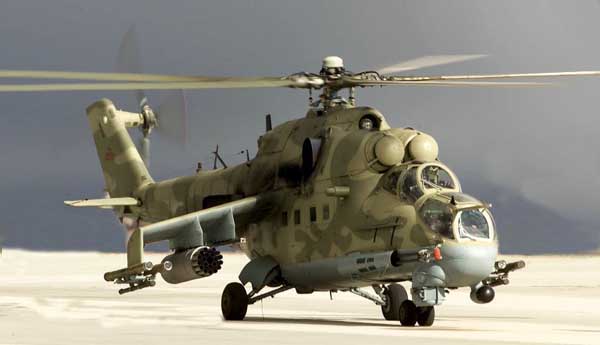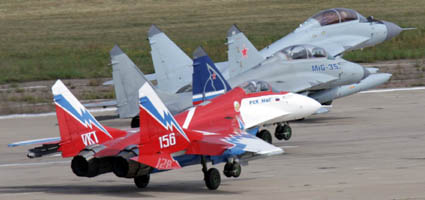 |
|
| Classifieds I Travel I Exporters Listings I Importers I Trade Help I Business I Export ads I Publishing I RegisterBus I | |

MI-24 RUSSIAN HELICOPTER

|
MI-24 Hind Russian Helicopter
This heavily armed attack helicopter is an armored troop carrier Mi-24 and a powerful, heavy and tough helicopter. max speed:310 km/h; standard range:7500 km; climb rate:750 m/min WE DO NOT SELL MI-24 HELICOPTERS AS FROM 2022
VARIANTS: --- from Janes Mi-24A (`Hind-A, B and C'): These early versions had a pilot and co-pilot/gunner in tandem under continuous glazing; large flight deck; about 250 were built, including Mi-24U unarmed dual-control trainers (first flight 1972);---- 1989-90 Jane's. Mi-24D (Type 24-6; `Hind-D'): Interim gunship version; design in 1971; produced at the Arsenyev and Rostov plants 1973; about 350 built 1973-77. Basically a `Hind-A' with TV3-117 engines and port-side tail rotor, entire front fuselage redesigned above floor forward of engine air intakes; separate armored cockpits for weapon operator and pilot in tandem; flight mechanic optional, in main cabin; transport capability retained; USUP-24 gun system, with rangefinding; undernose JakB-12.7 four-barrel 12.7 mm machine gun in turret, slaved to adjacent KPS-53A electro-optical sighting pod, for air-to-air and air-to-surface use; Falanga P (Phalanx) anti-tank missile system; nosewheel leg extended to increase ground clearance of sensor pods; nosewheels semi-exposed when retracted. Mi-24DU dual-control training version has no gun turret. Mi-24V (Types 20-1and 24-2; `Hind-E'): As Mi-24D, with modified wingtip launchers and four underwing pylons; weapons include up to eight 9M114 (AT-6 `Spiral') radio guided tube-launched anti-tank missiles in pairs in Shturm V (Attack) missile system; ASP-17V enlarged undernose automatic missile guidance pod on port side, with fixed searchlight to rear; R-60 (K-60; AA-8 `Aphid') air-to-air missiles optional on underwing pylons; pilot's HUD replaces former reflector gunsight. Deliveries to Soviet Air Force began 29 March 1976; about 1,000 built at Arsenyev and Rostov 1976-86. (See also Mi-35.) Mi-24VM: Proposed upgraded Mi-24V first shown in model form at Moscow Air Show '95. Mi-28 main and tail rotors and nose turret for twin 23 mm cannon; large IR suppressors scabbed to fuselage sides. Mi-24VP: Variant of Mi-24V with twin-barrel 23 mm gun, with 450 rounds, in place of four-barrel 12.7 mm gun in nose; photographed 1992; small production from Rostov. Mi-24P (Type 24-3; `Hind-F'): built 1974; about 620 built 1981-90; P of designation refers to pushka = cannon; as Mi-24V, but nose gun turret replaced by GSh-30-2 twin-barrel 30 mm gun (with 750 rounds) in semi-cylindrical pack on starboard side of nose; bottom of nose smoothly faired above and forward of sensors. Mi-24R (Type 46-2; `Hind-G1'): Identified at Chernobyl after April 1986 accident at nuclear power station; no undernose electro-optical and RF missile guidance pods; instead of wingtip weapon mounts, has `clutching hand' mechanisms on lengthened pylons, to obtain six soil samples per sortie, for NBC (nuclear/biological/chemical) warfare analysis; air samples sucked in via pipe on port side, aft of doors; datalink to pass findings to ground; lozenge shape housing with exhaust pipe of air filtering system under port side of cabin; bubble window on starboard side of main cabin; small rearward-firing marker flare pack on tailskid; crew of four wear NBC suits; deployed six per helicopter regiment throughout CIS ground forces. Designation (also appearing as Mi-24RCh) indicates Razvedchik: reconnaissance/chemical. About 150 built 1983-89. Mi-24K (korrektirovchik: corrector) (`Hind-G2'): As Mi-24R, but with large camera in cabin, f8/1,300 mm lens on starboard side; six per helicopter regiment for reconnaissance and artillery fire correction; gun and B-8V-20 rocket pods retained. No target designator pod under nose; upward hinging cover for IR sensor. About 150 built 1983-1989.
Mi-24BMT: A few modified 1973 for minesweeping. Mi-24PS: Special version for Russian Ministry of Internal Affairs; prototype displayed at Moscow Air Show '95. Equipment includes undernose FLIR ball; searchlight pod outboard of this on port side, loudspeaker pack on starboard side; hoist; climbdown ropes; stations for radio operators. Mi-24 Ecological Survey Version: Modification by Polyot industrial research organisation, to assess oil pollution on water and seasonal changes of water level. First seen 1991 with large flat sensor `tongue' projecting from nose in place of gun turret; large rectangular sensor pod on outer starboard underwing pylon; unidentified modification replaces rear cabin window on starboard side. Mi-25: Export Mi-24D, including those for Afghanistan, Cuba and India. Mi-35: Export Mi-24V. Unarmed, dual control trainer version also produced for India. Mi-35P: Export Mi-24P. Mi-35M: Upgraded night-capable version of Mi-24/35 designed to meet the latest air mobility requirements of the Russian Army. Features include Mi-28 main and tail rotors and transmission; 1,636 kW (2,194 shp) Klimov TV3-117VMA engines; new avionics; a reduced empty weight resulting from new titanium main rotor head, composites rotor blades, shortened stub-wings and non-retractable landing gear; a 23 mm GSh-23-2 twin-barrel gun in nose turret, with 470 rounds; up to 16 radio-guided 9M114 (AT-6 `Spiral'), or laser-guided 9M-120 anti-tank, 9M-120F blast fragmentation or 9A-220 air-to-air versions of Ataka (AT-12) missile; or a range of armament options including GUV gun/grenade pods; UPK-23-250 gun pods; B-8V-20 and B-13L rocket pods; S-24B rockets; and KMGU pods of anti-armor and anti-personnel mines. Night Operation Capable Avionics System (NOCAS) by Sextant Avionique and Thomson-TTD Optronic integrates Chlio FLIR ball with a TMM-1410 display, providing night vision for target acquisition and identification, missile guidance and gun aiming. Other equipment includes a VH-100 HUD, NVGs, liquid-crystal MFD, Nadir 10 mission management and navigation system, laser-gyro INS and GPS. The FLIR ball is mounted outboard of the standard missile guidance pod. Ability to carry Igla V air-to-air missiles is optional. Non-flying demonstrator first displayed at 1995 Paris Air Show.
DESIGN FEATURES: Typical helicopter gunship configuration, with stepped tandem seating for two crew and heavy weapon load on stub-wings; fuselage unusually wide for role, due to requirement for carrying eight troops; dynamic components and power plant originally as Mi-8, but soon upgraded to Mi-17-type power plant and port-side tail rotor. Main rotor blade section NACA 230, thickness/chord ratio 11 to 12 per cent; tail rotor blade section NACA 230M; stub-wing anhedral 12°, incidence 19°; wings contribute approximately 25 per cent of lift in cruising flight; fin offset 3°. HELICOPTER FRAME: Five-blade constant-chord main rotor; forged and machined steel head, with conventional flapping, drag and pitch change articulation; each blade has aluminum alloy spar, skin and honeycomb core; spars nitrogen pressurized for crack detection; hydraulic lead/lag dampers; balance tab on each blade; aluminum alloy three-blade tail rotor; main rotor brake; all-metal semi-monocoque fuselage pod and boom; 5 mm hardened steel integral side armor on front fuselage; all-metal shoulder wings with no movable surfaces; swept fin/tail rotor mounting; variable incidence horizontal stabilizer. LANDING GEAR: Tricycle type; rearward-retracting steerable twin-wheel nose unit; single-wheel main units with oleo-pneumatic shock-absorbers and low-pressure tires, size 720 x 320 mm on mainwheels, 480 x 200 mm on nosewheels. Main units retract rearward and inward into aft end of fuselage pod, turning through 90° to stow almost vertically, discwise to longitudinal axis of fuselage, under prominent blister fairings. Tubular tripod skid assembly, with shock-strut, protects tail rotor in tail-down take-off or landing. POWER PLANT: Two Klimov TV3-117MT turboshafts, each with T-O rating of 1,434 kW (1,923 shp), side by side above cabin, with output shafts driving rearward to main rotor shaft through combining gearbox. There is 5 mm hardened steel armor protection for engines. Main fuel tank in fuselage to rear of cabin, with bag tanks behind main gearbox. Internal fuel capacity 1,500 kg (3,307 lb); can be supplemented by 1,000 kg (2,205 lb) auxiliary tank in cabin (Mi-24D); provision for carrying (instead of auxiliary tank) up to four external tanks, each 500 liters (132 US gallons; 110 Imp gallons), on two inner pylons under each wing. Optional deflectors and separators for foreign objects and dust in air intakes; and infra-red suppression exhaust mixer boxes over exhaust ducts. CREW: Pilot (at the rear) and weapon operator on armored seats in tandem cockpits under individual canopies; dual flying controls, with retractable pedals in front cockpit; if required, flight mechanic on jump-seat in cabin, with narrow passage between flight deck and cabin. Front canopy hinged to open sideways to starboard; footstep under starboard side of fuselage for access to pilot's rearward-hinged door; rear seat raised to give pilot unobstructed forward view; anti-fragment shield between cockpits. Main cabin can accommodate eight persons on folding seats, or four stretchers; at front of cabin on each side is a door, divided horizontally into two sections hinged to open upward and downward respectively, with integral step on lower portion. Optically flat bulletproof glass windscreen, with wiper, for each crew member. SYSTEMS: Cockpits and cabin are heated and ventilated. Has a dual electrical system, with three generators, giving 36, 115 and 208 V AC at 400 Hz, and 27 V DC. Retractable landing/taxiing light under the nose; navigation lights; anti-collision light above tailboom. Stability augmentation system. Electrothermal de-icing system for main and tail rotor blades. AI-9 V APU mounted transversely inside fairing aft of rotor head for engine starting and ground services.
AVIONICS: Comms: Include VHF and UHF radio. Flight: Autopilot, ARK-15M radio compass, ARK-U2 radio compass, RV-5 radio altimeter. Instrumentation: Blind-flying instrumentation, and ADF navigation system with Doppler-fed mechanical map display. Air data sensor boom forward of top starboard corner of bulletproof windscreen at extreme nose. Mission: Undernose pods for electro-optics (starboard) and Raduga-F semi-automatic missile guidance (port). Many small antennae and blisters, including SRO-2 Khrom (`Odd Rods') IFF transponder. Self-defence: Sirena-3M radar warning antennae on each side of front fuselage and on trailing-edge of tail rotor pylon. Infra-red jammer (L-166V-11E Jspanka microwave pulse lamp: `Hot Brick') in `flower pot' container above forward end of tailboom. ASO-2V flare dispensers under tailboom forward of tailskid assembly initially; later triple racks (total of 192 flares) on sides of center-fuselage. EQUIPMENT: Gun camera on port wingtip. Color-coded identification flare system. WHO USES THEM: Algire, Angola, Afghanistan, Bangladesh, Belarus, Bosnia and Herzegovina, Bulgaria, Bhutan, Czech republic, Egypt, Etiopia, Finland, Croatia, India, Iraq, Yemen, Armenia, Yugoslavia, Kampuchia, Kazahstan, China, Congo, Cuba, Laos, Libya, Lithuania, Madagscar, Hungary, Macedonia, Mali, Moldova, Mongolia, Mozambique, Germany, Nicaragua, Pakistan, Peru, Poland, Republika Srpska, Romania, Russia, North Korea, Sierra Leone, Syria, Slovakia, Sudan, Sri Lanka, Tajikistan, Turkmenistan, Turkey, Ukraine, Uzbekistan, Venecuela, Vietnam, Zambia |
![]()
FOR SALE AND SERVICE
We sell used and new Russian helicopters & deliver direct to you or you collect. We also service all Russian helicopters. All NEW helicopter sales we invite you to visit our manufacturing helicopter factory. We can execute your order for you either in Ulan-Ude or in Kazan. We can deliver to you via heavy Antanov-A124 heavy- lift plane to your country. We accept applications for repairs and sales of your helicopters.
MAKS is an international airshow held at Zhukovsky International Airport,
the home of the Gromov Flight Research Institute in Zhukovsky
 |
Read more about the ![]() [ Russian drone helicopter for sale ] [ Russian Gyro Commander & Hunter helicopters ] [ NEW Unmanned UAV
[ Russian drone helicopter for sale ] [ Russian Gyro Commander & Hunter helicopters ] [ NEW Unmanned UAV ![]() ]
]
[ NEW Mi-38 for orders ] [ NEW
SPECS Mi8-MSB Helicopter sales ![]() ] [ Production Line Mi8-MSB Helicopter ] [ Mi 2 Mi2-MSB2 Helicopter for sale
] [ Production Line Mi8-MSB Helicopter ] [ Mi 2 Mi2-MSB2 Helicopter for sale ![]() ]
]
MI26T Medical evac[ MI-26T ], firefighting [ MI-26T ], Cranes & heavy lift [ MI-26T ][ More pics of MI-26 for sale ] [ NEW Unmanned UAV ![]() ] [ NEW
Helicopter sales ] [ MI-14 FIRE SERVICE helicopter for sale ] [ KA-32
Sales ] [ MI-8
sales ] [ MI-17 ] [ MI -17 Specs ] [ MI-171 Sales ]
[ MI-17 VIP
conversions ] [ Parts
& radio componants ] [ MI-24 ] [ MI-34 NEW Sales [ Antonov
An-124 CHARTER ] [ Leasing
helicopters ] [ Order
Sales Form ] [ Payment
terms ] [ LA8
Seaplanes ] [ Helicopter
parts free ads sell/buy ] [ Antonov
An-22 ] [ Western
AK1 helicopter ] [ CHINOOK 414 HELICOPTER SPARES ] [ BO-105 HELICOPTER SPARES ] [ West:
NZ stealth & rescue helicopter ]
] [ NEW
Helicopter sales ] [ MI-14 FIRE SERVICE helicopter for sale ] [ KA-32
Sales ] [ MI-8
sales ] [ MI-17 ] [ MI -17 Specs ] [ MI-171 Sales ]
[ MI-17 VIP
conversions ] [ Parts
& radio componants ] [ MI-24 ] [ MI-34 NEW Sales [ Antonov
An-124 CHARTER ] [ Leasing
helicopters ] [ Order
Sales Form ] [ Payment
terms ] [ LA8
Seaplanes ] [ Helicopter
parts free ads sell/buy ] [ Antonov
An-22 ] [ Western
AK1 helicopter ] [ CHINOOK 414 HELICOPTER SPARES ] [ BO-105 HELICOPTER SPARES ] [ West:
NZ stealth & rescue helicopter ]
![]()
|
|
COPYRIGHT: No parts or parts of this website may be copied, printed or circulated for publication in any form or part of without the express written permission of SEAsia Trading Post. Please also note all Thailand affected pages which include eg. law, immigration, visas can not be used unless written permission is obtained SEAsia Trading Post by way of contract. All infringements will be an infringement of privacy and our company will act accordingly. See FAQs












